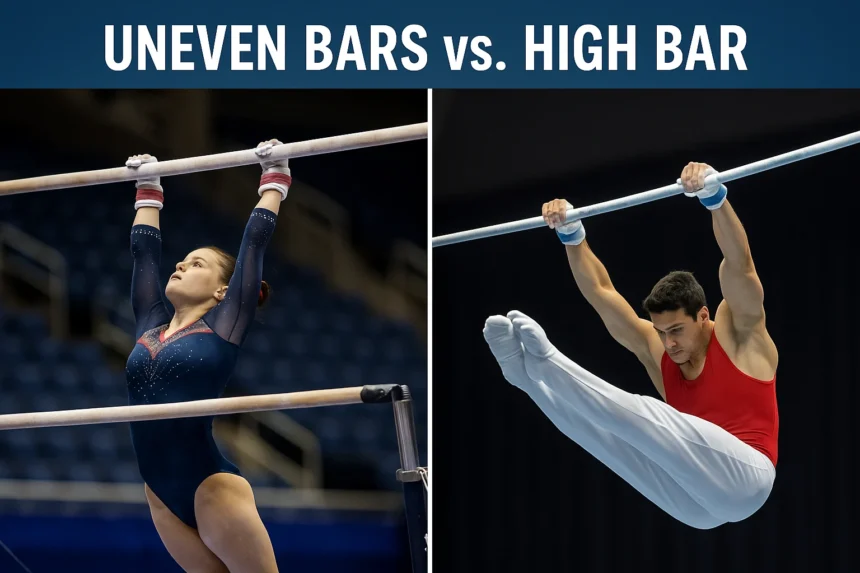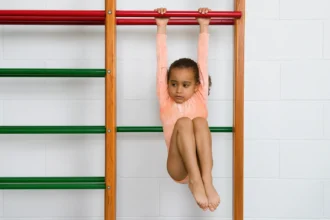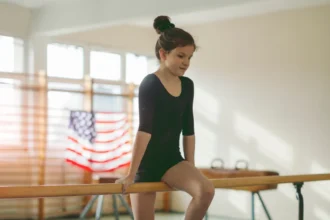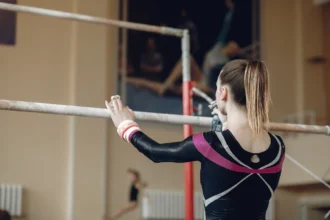In artistic gymnastics, the uneven bars in Women’s Artistic Gymnastics (WAG) and the high bar in Men’s Artistic Gymnastics (MAG) may look like distant cousins. They both feature swinging, flight, and a single horizontal rail surface, but they serve very different purposes in the sport.
Let’s take a closer look at how they align, how they differ, and what makes each unique.
Apparatus Overview
Uneven Bars (UB) – Women’s Artistic Gymnastics (WAG)
Two horizontal rails set at different heights, designed for a mix of swing mechanics, bar-to-bar transitions, and high-flying releases.
Standard FIG Measurements:
- High bar height: 250 cm (8’ 2.4”)
- Low bar height: 170 cm (5’ 6.9”)
- Distance between bars: Adjustable, typically 130–180 cm (51–71”)
- Bar diameter: ~40 mm (1.57 in)
- Material: Fiberglass core with wood veneer for grip comfort
Performance Role:
The uneven bars challenge gymnasts to combine swings, transitions, and releases in a seamless routine. By linking high- and low-bar elements creatively, athletes can earn combination bonuses, improve difficulty scores, and fulfill all composition requirements.
High Bar (HB) – Men’s Artistic Gymnastics (MAG)
A single horizontal rail positioned high above the floor, designed for continuous swinging, daring release elements, and large amplitude skills.
Standard FIG Measurements:
- Height above floor: 280 cm (9’ 2.2”)
- Bar diameter: 28 mm (1.1”), thinner for quicker regrips during high-speed releases
- Material: Steel core with wood veneer
- Flexibility: Slightly bends under force, aiding rhythm and cushioning regrips
Performance Role:
With no second bar to transition to, high bar routines are built around sustained motion. The event emphasizes massive release moves, complex pirouettes, and aerial dismounts, often with more flips and twists than are possible on uneven bars.
Purpose, Style, and Skill Examples
Uneven Bars
The uneven bars are a canvas for rhythm and variety. Routines mix continuous swings with precise bar-to-bar transitions, each skill flowing naturally into the next. Gymnasts alternate between the high and low bar, often shifting the routine’s tempo or direction with every transfer.
Flight skills like the Pak salto (high to low) or Shaposhnikova (low to high) are signature moments, providing both difficulty and visual impact. Judges reward pointed toes, tight body lines, and a consistent rhythm without unnecessary pauses. The performance ends with a powerful dismount, often a double layout or full-twisting double back, stuck cold for maximum impression.
High Bar
The high bar is pure adrenaline. Athletes mount, swing into giants, and then unleash high-flying release moves such as the Kovacs (double back over the bar) or Cassina (full-twisting double back). The momentum never stops; skills are linked back-to-back in a single sweeping arc of motion.
Because the apparatus is taller and the swing speed higher, gymnasts can perform more somersaults and twists in a single release than on uneven bars. Pirouettes like the Adler or Yamawaki half demand precise timing and grip security. Routines build to an explosive finish, often a double-twisting double layout or even a triple back dismount that sends the crowd into applause.
Skills at a Glance
| Skill Type | Uneven Bars (WAG) | High Bar (MAG) |
|---|---|---|
| Release Moves | Tkatchev, Jaeger, Pak salto, Nabieva | Kovacs, Kolman, Cassina, Gaylord |
| Transitions | Pak salto (high→low), Shaposhnikova (low→high), Bail to handstand | None (single bar only) |
| Pirouettes | Stalder full, Healy turn, Endo full | Stalder full, Adler, Yamawaki half |
| Aerial Complexity | Primarily single or double somersaults with twists, often tied to transitions | Multiple flips and twists in one release, e.g., Cassina |
| Dismounts | Double layout, full-twisting double back | Double-twisting double layout, triple back |
Judging Requirements (FIG Code of Points)
Uneven Bars (WAG)
Special Requirements:
- Flight from high bar to low bar (e.g., Pak salto, Bhardwaj)
- Flight from low bar to high bar (e.g., Shaposhnikova, Maloney)
- Use of different grips (regular, L-grip, mixed)
- At least two flight elements (including releases, transitions, or dismount)
Additional Notes:
- Dismount must be C value or higher.
- Artistry deductions apply for poor rhythm, pauses, or lack of connection.
- Falls cost 1.0; remount must be within 30 seconds.
High Bar (MAG)
Special Requirements:
- Forward flight element (e.g., Gaylord, forward Tkatchev)
- Backward flight element (e.g., Kovacs, Cassina)
- One in-bar element (e.g., Endo, stalder near the bar)
- Element in el-grip or dorsal grip
Additional Notes:
- Dismount must be C value or higher.
- No artistry deductions, but execution penalties apply for form, rhythm, and bent arms.
- Falls cost 1.0; remount must be within 30 seconds.
Training & Physical Demands
Uneven Bars:
Training emphasizes grip endurance, core control, and shoulder flexibility. Gymnasts must master timing for safe and efficient bar transfers, often drilling half-swings and shaping exercises to perfect transitions. Strength is needed, but control and precision rule this event.
High Bar:
Athletes focus on tap swing mechanics, explosive release height, and regrip confidence. Conditioning includes rope climbs, weighted pull-ups, and swing-to-release drills. The ability to hold rhythm through pirouettes and high-flying releases is essential.
Key Similarities
- Both require exceptional grip strength, timing, and swing mechanics.
- Both build around giants, releases, pirouettes, and a high-difficulty dismount.
- Both demand handstands held within 10° of vertical for full credit.
- Both judged under the FIG Code of Points with similar scoring structure.
Key Contrasts
- Number of Bars: Uneven bars require coordination between two heights; high bar uses one.
- Transitions: Core to uneven bars; absent on high bar.
- Bar Diameter: Uneven bars are thicker for hand comfort; high bar is thinner for quick regrips.
- Aerial Difficulty: High bar allows greater flipping/twisting potential due to height and swing speed.
- Artistry: Uneven bars can incur artistry deductions; high bar does not.
In summary, the uneven bars show off grace, creativity, and smooth transitions. The high bar is all about big swings, daring releases, and powerful dismounts. Both come from the same swing-style gymnastics, but each has grown into its own unique challenge.






